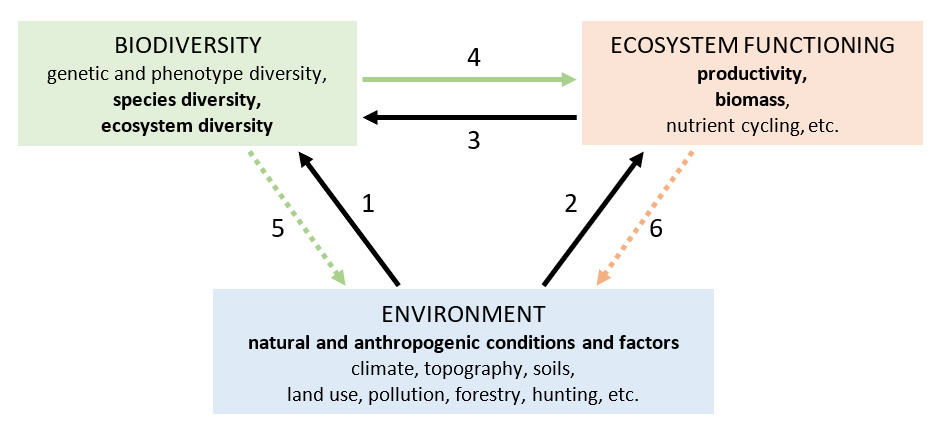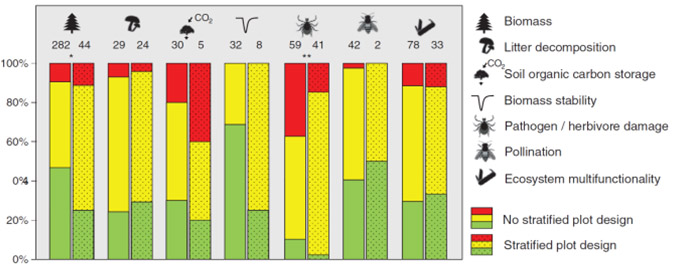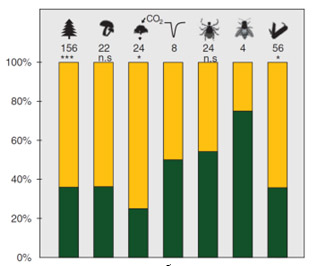Interconnections between biodiversity and ecosystem functions and services
Page is under construction
Biodiversity is now recognized as a key factor in ecosystem functioning and human well-being. Biodiversity is the basis of all the benefits that humans receive from nature known as “ecosystem services” or “nature’s contributions to people.” (IPBES, 2018, 2019). Ultimately, the very possibility of human life on Earth is determined by the functioning of natural ecosystems and biosphere regulation, which modern humanity is not able to replace by artificial means on a global scale. Biodiversity loss weakens and destabilizes ecosystem functions and services, and undermines human well-being and opportunities for sustainable development.
Biodiversity, ecosystem functions and environmental conditions are inextricably linked into a single system. The influence of the environment and ecosystem productivity on indicators of biodiversity (for example, latitudinal and altitudinal gradients of species diversity) has long been included in ecology textbooks and is referred to as the “classical paradigm” of the relationship between biodiversity and the environment (black arrows in the figure below). However, in recent decades, ecological science has made great efforts to study the opposing effects, namely the influence of biodiversity on ecosystem functions and services. The results of these studies formed the so-called “new paradigm”, which considers the mutual influences between all components of this system (Loreau, 2010; Van der Plas, 2019; Eisenhauer et al., 2019). Biodiversity is now considered not only as an adaptation of living nature in response to environmental influences, but as an active factor shaping ecosystem functions, and through them, environmental indicators.

The new paradigm of interactions between environment, biodiversity and ecosystem functioning (after Loreau, 2010; Van der Plas, 2019; Eisenhauer et al., 2019, with changes). Black arrows 1, 2, 3 show classic paradigm: environmental conditions and productivity drive biodiversity. Color arrows show new paradigm: 4 – causal effects of biodiversity on ecosystem functioning (BEF experiments and observations of real world systems when variations in other factors are minimal); 5, 6 – biodiversity and ecosystem functions affect environment through ecosystem engineering, niche construction, regulating of environment.
Even a simple mechanistic comparison of ecosystems to machines, and the biosphere to a huge spaceship called the Earth, makes clear the importance of biodiversity, that is, the diversity of the functional details of these systems. In recent decades, environmental science has made great efforts to prove this. Hundreds of experiments and surveys of real-world systems have shown the predominance of positive effects of species richness on the extent and sustainability of ecosystem functions.

Results of surveys of real-world ecosystems: the proportion of positive (green), neutral (yellow) and negative (red) effects of species richness on ecosystem functions (Van der Plas, 2019).
 Relative importance of biodiversity (green) and abiotic environmental factors (yellow) (Van der Plas, 2019).
Relative importance of biodiversity (green) and abiotic environmental factors (yellow) (Van der Plas, 2019).
To ensure ecosystem functions and services, all hierarchical levels of biodiversity are important – genetic and phenotypic diversity in populations, diversity of populations and subspecies within species, diversity of species within communities and ecosystems, diversity of ecosystems within landscapes and territories of different scales. To assess the diversity of species, different indicators are used (different indices of species, functional and phylogenetic diversity), but the overwhelming majority of works examine the indicator of species richness (number of species), as the most easily determined.